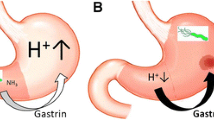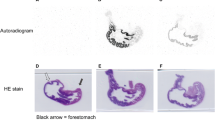Abstract
Clinical conditions with low gastric acidsecretion have been associated with increased risk ofgastric cancer. There has also been concern aboutgastric acid inhibition and N-nitroso compound formation in the stomach. This study investigates theeffect of gastric acid secretion on the penetration ofN-3H-methyl-N-nitro-N-nitrosoguanidine, anN-nitroso compound and gastric carcinogen, into thegastric mucosa of rats. Gastric acid secretion wasstimulated by pentagastrin (40 μg/kg/hr) andinhibited by omeprazole (40 mumol/kg) before mucosalexposure toN-3H-methyl-N-nitro-N-nitrosoguanidine.Penetration of the carcinogen was evaluated by lightmicroscopic identification of cells in the S-phaselabeled withN-3Hmethyl-N-nitro-N-nitrosoguanidine. Thispopulation of double-labeled cells is considered at risk fromN3-methyl-N-nitro-N-nitrosoguanidine-inducedcarcinogenesis. The percentage of double-labeled cellswas significantly higher in antrum than in corpus mucosa(P < 0.0001). Stimulation or inhibition of gastric acid secretion did notaffect the penetration of N-3H-methyl-N-nitro-N-nitrosoguanidine in antrum or corpusmucosa. We conclude that modulation of gastric acidsecretion does not affect the penetration of the carcinogeninto the gastric mucosa nor does it explain thedifferent penetration of the carcinogen into corpus andantrum mucosa.
Similar content being viewed by others
REFERENCES
Correa P, Schmidt BA: The relationship between gastric can-cer frequency and the ratio of gastric to duodenal ulcer. Aliment Pharmacol Ther 9 (suppl 2):13–19, 1995
Lee S, Iida M, Yao T, Shindo S, Nose Y, Akazawa K, Okabe H, Fujishima M: Risk of gastric cancer in patients with nonsurgically treated peptic ulcer. Scand J Gastroenterol 25:1223–1226, 1990
Hansson LE, Nyren O, Hsing AW, Bergstrom R, Josefsson S, Chow WH, Fraumeni JF Jr, Adami HO: The risk of stomach cancer in patients with gastric or duodenal ulcer disease. N Engl J Med 335:242–249, 1996
Molloy RM, Sonnenberg A: Relation between gastric cancer and previous peptic ulcer disease. Gut 40:247–252, 1997
Rios Castellanos E, Sitas F, Shepherd NA, Jewell DP: Changing pattern of gastric cancer in Oxfordshire. Gut 33:1312–1317, 1992
Hansen S, Wiig JN, Giercksky KE, Tretli S: Esophageal and gastric carcinoma in Norway 1958-1992: Incidence time trend variability according to morphological subtypes and organ subsites. Int J Cancer 71:340–344, 1997
Takahashi M, Hasegawa R: Pathology of tumours in laboratory animals. Tumours of the rat. Tumours of the stomach. IARC Sci Publ 99:129–157, 1990
Breaux JR, Bringaze W, Chappuis C, Cohn I Jr: Adenocarcinoma of the stomach: A review of 35 years and 1710 cases. World J Surg 14:580–586, 1990
Ryberg B, Bishop AE, Bloom SR, Carlsson E, Hakanson R, Larsson H, Mattsson H, Polak JM, Sundler F: Omeprazole and ranitidine, antisecretagogues with different modes of action, are equally effective in causing hyperplasia of enterochromaf-fin-like cells in rat stomach. Regul Pept 25:235–246, 1989
Havu N: Enterochromaffi n-like cell carcinoids of gastric mucosa in rats after life-long inhibition of gastric secretion. Digestion 35( suppl 1):42–55, 1986
Berlin RG: Omeprazole. Gastrin and gastric endocrine cell data from clinical studies. Dig Dis Sci 36:129–136, 1991
Lamberts R, Creutzfeldt W, Struber HG, Brunner G, Solcia E: Long-term omeprazole therapy in peptic ulcer disease: Gastrin, endocrine cell growth, and gastritis. Gastroenterology 104:1356–1370, 1993
Moller H, Nissen A, Mosbech J: Use of cimetidine and other peptic ulcer drugs in Denmark 1977-1990 with analysis of the risk of gastric cancer among cimetidine users. Gut 33:1166–1169, 1992
Colin Jones DG, Langman MJ, Lawson DH, Logan RF, Paterson KR, Vessey MP: Post-cimetidine surveillance for up to ten years: Incidence of carcinoma of the stomach and oesophagus. Q J Med 78:13–19, 1991
Solcia E, Fiocca R, Havu N, Dalvag A, Carlsson R: Gastric endocrine cells and gastritis in patients receiving long-term omeprazole treatment. Digestion 51(suppl 1):82–92, 1992
Yeomans ND: Omeprazole: Short-and long-term safety. Adverse Drug React Toxicol Rev 13:145–156, 1994
McCloy RF, Arnold R, Bardhan KD, Cattan D, Klinkenberg Knol E, Maton PN, Riddell RH, Sipponen P, Walan A: Pathophysiological effects of long-term acid suppression in man. Dig Dis Sci 40:96S–120S, 1995
Leach SA, Thompson M, Hill M: Bacterially catalysed N-nitrosation reactions and their relative importance in the human stomach. Carcinogenesis 8:1907–1912, 1987
Calmels S, Bereziat JC, Ohshima H, Bartsch H: Bacterial formation of N-nitroso compounds from administered precursors in the rat stomach after omeprazole-induced achlorhydria. Carcinogenesis 12:435–439, 1991
Xu GP, Reed PI: N-nitroso compounds in fresh gastric juice and their relation to intragastric pH and nitrite employing an improved analytical method. Carcinogenesis 14:2547–2551, 1993
Correa P: Human gastric carcinogenesis: a multistep and multifactorial process—first American Cancer Society award lec-ture on cancer epidemiology and prevention. Cancer Res 52:6735–6740, 1992
Sorbye H, Kvinnsland S, Svanes K: Penetration of N-me thyl-N′-nitro-N-nitrosoguanidine to proliferative cells in gastric mucosa of rats is different in pylorus and fundus and depends on exposure time and solvent. Carcinogenesis 14:887–892, 1993
Deveney CW, Freeman H, Way LW: Experimental gastric carcinogenesis in the rat: Effects of hypergastrinemia and acid secretion. Am J Surg 139:49–54, 1980
Tatsuta M, Yamamura H, Taniguchi H, Tamura H: Gastrin protection against chemically induced gastric adenocarcinomas in Wistar rats: Histopathology of the glandular stomach and incidence of gastric adenocarcinoma. J Natl Cancer Inst 69:59–66, 1982
Tatsuta M, Itoh T, Okuda S, Taniguchi H, Tamura H: Effect of prolonged administration of gastrin on experimental carcinogenesis in rat stomach induced by N-me thyl-N′-nitro-Nnitrosoguanidine. Cancer Res 37:1808–1810, 1977
Tatsuta M, Yamamura H, Ichii M, Taniguchi H: Promotion by histamine of carcinogenesis in the forestomach and protection by histamine against carcinogenesis induced by N-nitroso-N-me thylnitroguanidine in the glandular stomach in W rats. J Natl Cancer Inst 71:361–364, 1983
Pitot HC, Dragan YP: Facts and theories concerning the mechanisms of carcinogenesis. FASEB J 5:2280–2286, 1991
Ohgaki H, Tomihari M, Sato S, Kleihues P, Sugimura T: Differential proliferative response of gastric mucosa during carcinoge nesis induced by N-methyl-N′-nitro-N-nitrosoguanidine in susceptible ACI rats, resistant Buffalo rats, and their hybrid F1 cross. Cancer Res 48:5275–5279, 1988
Rogers AW: Autoradiographic Background, Techniques of Autoradiography. Amsterdam, Elsevier/North-Holland Biomedical Press, 1979, p 111
Sorbye H, Ovrebo K, Gislason H, Kvinnsland S, Svanes K: Blood flow and mucoid cap protect against penetration of carcinoge ns into superficially injured gastric mucosa of rats. Dig Dis Sci 40:1720–1728, 1995
Lacy ER, Ito S: Microscopic analysis of ethanol damage to rat gastric mucosa after treatment with a prostaglandin. Gastroente rology 83:619–625, 1982
Larsson H, Mattson H, Sundell G, Carlsson E: Animal pharmacodynamics of omeprazole. A survey of its pharmacological properties in vivo.Scand J Gastroenterol Suppl 108:23–35, 1985
Pique JM, Leung FW, Tan HW, Livingston E, Scremin OU, Guth PH: Gastric mucosal blood flow response to stimulation and inhibition of gastric acid secretion. Gastroenterology 95:642–650, 1988
Bastaki SM, Waton G, Garner A: Effects of anaesthetic age nts on basal and histamine-stimulated acid secretion in the fistula rat. Eur J Gastroenterol Hepatol 7:1199–1202, 1995
Osterman Golkar S: Reaction kinetics of N-methyl-N′-nitro-N-nitrosoguanidine and N-ethyl-N′-nitro-N-nitrosoguanidine. Mutat Res 24:219–226, 1974
Allen A, Flemstrom G, Garner A, Kivilaakso E: Gastroduode-nal mucosal protection. Physiol Rev 73:823–857, 1993
Kobori O, Schmerold I, Ludeke B, Ohgaki H, Kleihues P: DNA me thylation in rat stomach and duodenum following chronic exposure to N-methyl-N′-nitro-N-nitrosoguanidine and the effect of dietary taurocholate. Carcinogenesis 9:2271–2274, 1988
Sorbye H, Kvinnsland S, Svanes K: Effect of salt-induced mucosal damage and healing on penetration of N-me thyl-N′-nitro-N-nitrosoguanidine to proliferative cells in the gastric mucosa of rats. Carcinogenesis 15:673–679, 1994
Nishizaki Y, Guth PH, Kim G, Wayland H, Kaunitz JD: Pentagastrin enhances gastric mucosal defense s in vivo:Luminal acid-dependent and independent effects. Am J Physiol 267:G94–G104, 1994
Synnerstad I, Holm L: Omeprazole induces high intraglandular pressure in the rat gastric mucosa. Gastroenterology 112:1221–1230, 1997
Seelig LL Jr, Schlusselberg DS, Smith WK, Woodward DJ: Mucosal nerves and smooth muscle relationships with gastric glands of the opossum: An ultrastructural and three-dimensional reconstruction study. Am J Anat 174:15–26, 1985
Hattori T: On cell proliferation and differentiation of the fundic mucosa of the golden hamster. Fractographic study combined with microscopy and [3H]thymidine autoradiography. Cell Tissue Res 148:213–226, 1974
Helander HF: Stereological changes in rat parietal cells after vagotomy and antrectomy. Gastroenterology 71:1010–1018, 1976
Tatsuta M, Iishi H, Yamamura H, Baba M, Yamamoto R, Taniguchi H: Effect of cimetidine on inhibition by tetragastrin of carcinogene sis induced by N-methyl-N′-nitro-N-nitrosoguanidine in Wistar rats. Cancer Res 48:1591–1595, 1988
Rights and permissions
About this article
Cite this article
Ovrebo, K.K., Sorbye, H., Kvinnsland, S. et al. Effect of Gastric Secretion on Penetration of N-3H-Methyl-N-nitro-N-nitrosoguanidine into Gastric Mucosa of Rats. Dig Dis Sci 43, 2012–2020 (1998). https://doi.org/10.1023/A:1018898928870
Issue Date:
DOI: https://doi.org/10.1023/A:1018898928870




